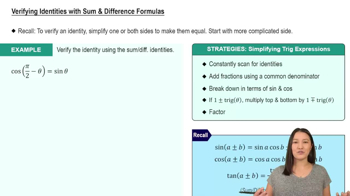Use identities to write each expression in terms of sin θ and cos θ, and then simplify so that no quotients appear and all functions are of θ only.
csc² θ + sec² θ
 Verified step by step guidance
Verified step by step guidance Verified video answer for a similar problem:
Verified video answer for a similar problem:



 6:19m
6:19mMaster Even and Odd Identities with a bite sized video explanation from Patrick
Start learning